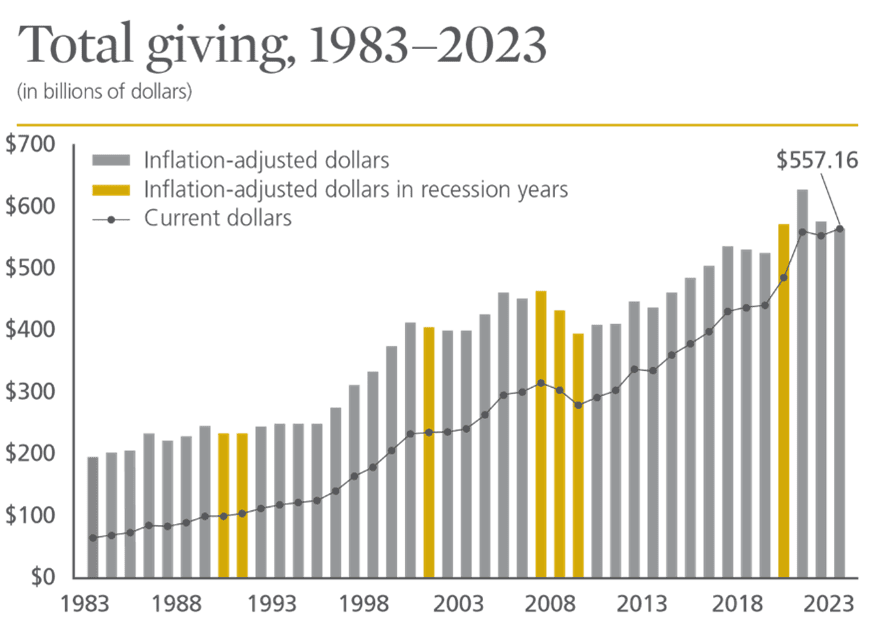The news is in. After an uncharacteristic decline in total giving in 2022, we saw an increase in 2023. Overall, giving in 2023 emerged stronger than many economists expected, considering an array of tensions and issues affecting the economy and philanthropic decisions.
Giving USA Foundation has released annual estimates of charitable giving for 2023, showing an increase in giving, with $557.16 billion total. After a rare decline in overall giving in 2022, Giving USA 2024: The Annual Report on Philanthropy for 2023 reports an increase of 1.9% in current dollars but saw a 2.1% decline when adjusted for inflation.
Key factors that positively influenced giving were growth in the Gross Domestic Product (GDP), Standard & Poor’s (S&P) 500 Index, and disposable personal income, even when adjusted for inflation.
The following key trends in giving by sources were notable in 2023:
- Compared to 2022, individual giving was up 1.6%, at $374.40 billion—but there was a 2.4% decline when adjusting for inflation. Individuals are still the largest source of giving at 67%, though that percentage of total giving has been decreasing since 2017 (70%). Following a year when giving declined for the first time since 2009, and two prior record years boosted by pandemic giving, 2023 donors were impacted by economic factors, including a recession and a higher-than-average inflation rate for the third consecutive year. Notably, individual giving as a percentage of disposable personal income was 1.7% in 2022, tying the lowest level recorded by GUSA, in 1995. For many, disposable personal income is linked to household income, which can determine how much is given philanthropically.
- Corporate giving grew by 3.0% in current dollars, reaching its second highest level on record. However, all four giving sources—foundation, individual, and bequest giving included—saw decreases when adjusting for inflation. Factors affecting corporate giving include a strong macroeconomic environment and an interest in adopting key ESG (environmental, social, and governance) commitments—the environment and social components in particular.
- Foundations are continuing to grow their share of total contributions over time, at 19%. Foundations comprised only 5% of total contributions in 1982. Foundation giving grew 1.7% in current dollars in 2023, at $103.53 billion, crossing the $100 billion mark for the second consecutive year. The number of foundations continues to grow, with half estimated to be family foundations, which can represent a different form of individual giving. Foundation giving represents grants made by independent, community, and operating foundations.
- Bequest giving grew 4.8% in current dollars in 2023, representing 8% of total giving. Giving by bequest is the most unpredictable source from one year to the next. In the past 40 years, bequest giving has experienced a gradual upward trend from $15.79 billion to $42.68 billion in 2023. Growth in bequests likely indicates demographic shifts and this total should grow with increasing numbers of older adults in coming years.
Giving to all nine charitable subsectors grew in current dollars compared to 2023, with Foundations (15.4%) and Education (11.1%) leading the way. Adjusting for inflation, Religion and International Affairs were the only subsectors demonstrating a decline, at 1.0% and 1.6%, respectively. In terms of percentage of overall giving, Religion (24%), Human Services (14%), and Education (14%) remained the top three subsectors, receiving 52% of all contributions, with giving to grant-making Foundations just slightly lower, at 13% of total giving.
Giving USA 2024: Key Implications for Fundraisers
Reflecting on this new Giving USA data, our experiences with clients, and in context of the current environment, JGA recommends the following strategies to grow generosity.
- Individual engagement is critical for donors. Why is individual giving lagging in comparison to other contribution sources? Part of this is that donors are using strategic vehicles, like donor-advised funds and family foundations, which have seen massive increases. This giving, while led by individuals, is represented in other counting areas. New data will be released soon aimed at addressing this question through the work of the Generosity Commission. JGA’s co-founder and Senior Consultant, Ted Grossnickle, has helped to lead efforts in this work.
We know that retaining current donors is more efficient than cultivating new donors. Focus on building your relationships with mid-level and larger donors as there is evidence of promising growth with these donors, particularly with the increase in bequest giving in recent years. Donors increasingly want to be involved in meaningful ways and sharing their impact through current stories and opportunities can help to further engage them in your mission. - Stay current on methods of giving and tools to help understand and connect with your donors. We know that the majority of younger donors give to nonprofits online and are more likely to respond to socially connected appeals. As Giving USA shared in the special report Giving By Generation, Millennial and Gen Z donors’ giving is influenced twice as much by social media than older donors. Nonprofits must ensure that multiple online giving options are available and that giving options are easy to see and to navigate. As new technology is developed, it is becoming more cost-effective for nonprofits of all sizes to embrace the power of predictive analytics and data-driven donor personas to focus your efforts and personalize the donor experience.
- Be proactive in addressing new challenges. Despite uneven economic conditions, personal income and consumer spending grew, lifting individual giving. There are often unexpected outcomes, so it is crucial to stay attuned to external issues and communicate with your donors accordingly, to stay connected and to hear what they are thinking. Conditions can change quickly, so your engagement in and response to key issues and events will serve your donors well.
- You’re not alone, and networking with peers and experts is key. Donors are changing, and fundraising strategies must change with them. Reach out to peers to get new ideas on how to meet the impact-driven, social, and strategic donors who are now at the forefront of giving. We encourage you to download a free copy of the Giving USA 2024 infographic or subscribe for a full copy of the report at givingusa.org.
Giving USA 2024: The Annual Report on Giving for 2023 is published by Giving USA Foundation, a public service initiative of The Giving Institute, and is the longest running and most comprehensive report on charitable giving in America. Giving USA is researched and created by the Indiana University Lilly Family School of Philanthropy. JGA is a member of The Giving Institute.

